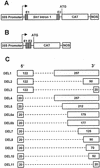Splicing of the maize Sh1 first intron is essential for enhancement of gene expression, and a T-rich motif increases expression without affecting splicing
- PMID: 12376656
- PMCID: PMC166618
- DOI: 10.1104/pp.008235
Splicing of the maize Sh1 first intron is essential for enhancement of gene expression, and a T-rich motif increases expression without affecting splicing
Abstract
Certain plant and animal introns increase expression of protein-coding sequences when placed in the 5' region of the transcription unit. The mechanisms of intron-mediated enhancement have not been defined, but are generally accepted to be post- or cotranscriptional in character. One of the most effective plant introns in stimulating gene expression is the 1,028-bp first intron of the Sh1 gene that encodes maize (Zea mays) sucrose synthase. To address the mechanisms of intron-mediated enhancement, we used reporter gene fusions to identify features of the Sh1 first intron required for enhancement in cultured maize cells. A 145-bp derivative conferred approximately the same 20- to 50-fold stimulation typical for the full-length intron in this transient expression system. A 35-bp motif contained within the intron is required for maximum levels of enhancement but not for efficient transcript splicing. The important feature of this redundant 35-bp motif is T-richness rather than the specific sequence. When transcript splicing was abolished by mutations at the intron borders, enhancement was reduced to about 2-fold. The requirement of splicing for enhancement was not because of upstream translation initiation codons contained in unspliced transcripts. On the basis of our current findings, we conclude that splicing of the Sh1 intron is integral to enhancement, and we hypothesize that transcript modifications triggered by the T-rich motif and splicing may link the mRNA with the trafficking system of the cell.
Figures


References
-
- Baynton CE, Potthoff SJ, McCullough AJ, Schuler MA. U-rich tracts enhance 3′ splice site recognition in plant nuclei. Plant J. 1996;10:703–711. - PubMed
-
- Bentley D. Coupling RNA polymerase transcription with pre-mRNA processing. Curr Opin Cell Biol. 1999;11:347–351. - PubMed
-
- Brown JWS, Smith P, Simpson CG. Arabidopsis consensus intron sequences. Plant Mol Biol. 1996;32:531–535. - PubMed
Publication types
MeSH terms
Substances
LinkOut - more resources
Full Text Sources
Other Literature Sources

